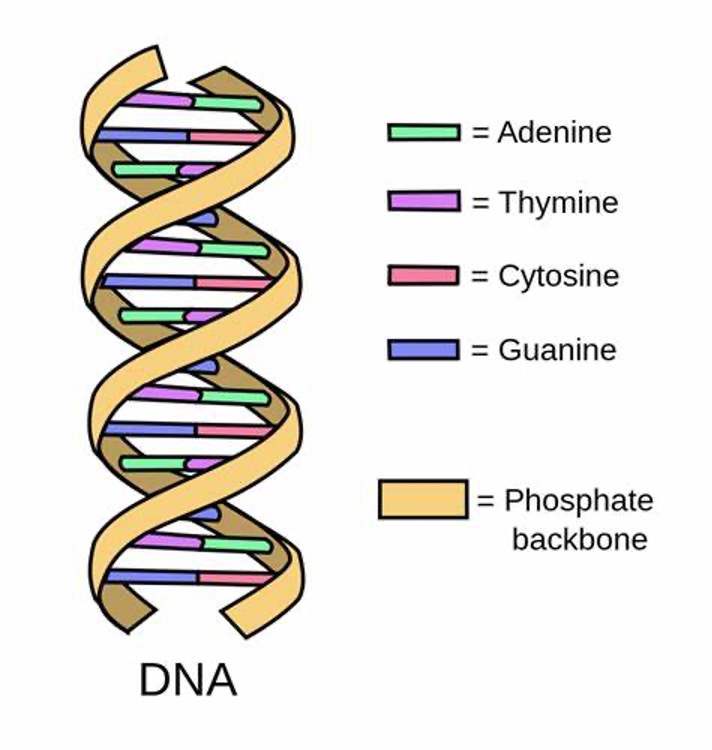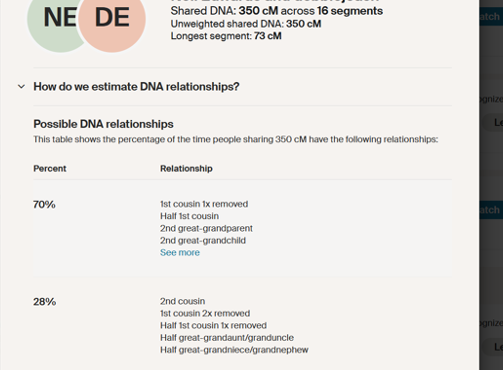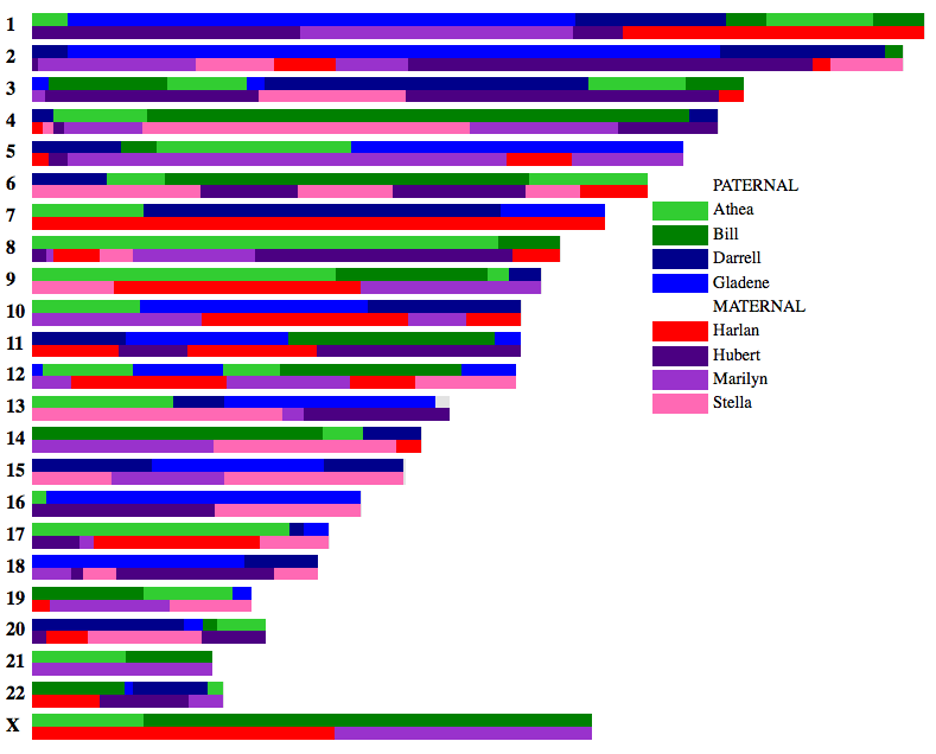What is the Longest Segment on Ancestry DNA?
Have you done an Ancestry DNA test and you've noticed the "Longest Segment" tool? In this article, we explain what the Longest Segment is and why it can potentially help you with your family tree research.
AncestryDNA has a number of cool tools when it comes to dealing with your matches but there is one that many of us probably do not even know about. This subtle tool came out in Aug 2020 and unless you go looking for it you could likely miss it.
This is not a complicated tool but the information you can gather from it could potentially be very helpful with your family tree research using your DNA matches. It is called the Longest Segment and as the name suggests it is simply the longest segment of DNA you share with a match.
What Are Centimorgans?
In order to better understand what Longest Segment means we first need to learn a little about measuring DNA matches. We measure our matches in units known as centimorgans (cM). This is a unit that roughly translates to a million base pairs of our DNA sequence.
When we are comparing our DNA to one of our AncestryDNA matches we are looking for sequences that we both share. The more sequences that we have in common and the longer they are, the closer we are likely to be related to a person.
Each person has around 6800 centimorgans of measured DNA so the amount of DNA we share with another person using this unit of measurement can help determine our familial relationship. As an example, a parent and child share about 50% of their DNA meaning that their centimorgan match would be roughly 3400 centimorgans. The higher the match the closer the relationship.

What Does Longest Segment Mean?
The DNA we share with someone is not usually based on just one segment of our DNA. Unless of course, the connection is more distant. Close relationships usually have multiple segments of shared DNA which can vary in length.
So the longest segment of DNA we share is literally the longest section of DNA that we have in common with our DNA match. AncestryDNA tests millions of its users seeking those who have identical segments of DNA in order to form their DNA matches.
How Do I Find the Longest Segment on AncestryDNA?
As mentioned, this is not a well-known feature and if you don’t know you are looking for it you might just miss its importance. It isn’t hard to locate, however, as long as you know where to find it. So here’s a quick how-to for you.
- First, you have to log into your Ancestry account and locate the DNA tab in the toolbar at the top of the screen. Click this tab and you will get a dropdown menu that says "Your DNA Results," "Activate a Test" and "Buy Another Test." Choose “Your DNA Results.”
- The next screen will show your three main DNA tools: DNA Story, DNA Matches and Thrulines. You will want to open up the DNA matches section by clicking the blue box marked “View All DNA Matches.”
- You should now see a full list of all your DNA matches with names and two links next to them which estimate your potential relationship and state your shared centimorgans and DNA percentage. Choose a match and click on the link for the shared centimorgans and DNA percentage.
- You will now have a pop-up page that tells you the percentage likelihood of your relationship to your match. Near the top, you will see your name and the name of your match side by side. Three lines below this you will see the Longest Segment. The number next to that is the length of the longest segment of DNA that you share with that specific match.

On this same pop-up page you will also see the total length in centimorgans of your shared DNA and the number of segments this total comes from. As mentioned this can be multiple different segments or sometimes just one.
Why Is the Largest Segment So Important?
If you are not familiar with DNA inheritance you may not realize just how random it can be. We receive 50% of our DNA from each of our parents. After this, though it becomes more complicated. We receive 100% of our DNA as a combination of all 4 of our genetic grandparents. Instead of it being 25% from each grandparent, however, it usually varies and we may get more from one grandparent and less from another.
The reason this is important is that the DNA we receive from our ancestors has to be recombined so it does not always come in one long segment. When we share long segments of DNA with a match this usually means that we have a close common ancestor within the last few generations. Smaller segments of DNA usually indicate a more distant common ancestor.
We inherit long segments of DNA from our parents so this indicates just how close that genetic match is. Shorter segments may come from great-great-great-great grandparents and our match may have inherited that same short segment from that common ancestor. They would be a distant cousin rather than a close relation.
Even close cousins share long segments of DNA. For example, my first cousin and I share 848 centimorgans of DNA over 36 different segments. The longest of which is 92 cM long, over 10% of the total shared DNA. This is because we share the same grandparents and our respective parents were siblings.
How Do You Use the Longest Segment Information?
As DNA inheritance is a random process we often share multiple segments with our close familial relations rather than one large portion of DNA. It becomes separated and recombined with the other segments of DNA that we inherit from the other side of our family.
This does not mean that the longest segment feature has no worth in our research because as mentioned we can use this information to determine roughly how closely we are related to our AncestryDNA matches.

The longer the segment of DNA we share in common with a match the closer generationally we are related to that match. As a guideline, below is a list of the ranges and the considered size range.
- 100 Centimorgans or more = very large segment
- 50 – 100 centimorgans = large segment
- 12 – 50 centimorgans = medium segment
- 12 centimorgans or less = small segment
We will share some portion of our DNA with our close blood relatives within the past few generations. As an example, we will have DNA from our great-great-great grandparents but might possibly not get DNA from one of our great-great-great-great grandparents.
When it comes to cousins we should share DNA with all of them up to the second cousin once removed. However, we will not share DNA with all of our third cousins. This is because DNA inheritance can mean that after a few generations of separation even if they are blood relatives we might not get the same DNA from common ancestors so we would not even match.
Using the segment length to help estimate your relationship to a match can be done in a few ways so here are a few basic examples of how this might work.
Example 1
Charles has a well fleshed out tree going back 4 generations on all his lines and he feels confident it is as correct as possible. In his DNA matches, he has a person called Sandra who does not have a tree built on the site.
Their mutual largest segment of DNA is relatively small at just 9 cMs with their total shared DNA being 25 over three sections. This means the remaining two segments are split between the remaining 16 cMs making for three small shared segments.
The relationship based on these small segments seems to be of a distant nature and would likely fall into a fourth cousin range. Without a tree from Sandra, however, it is hard to determine the exact relationship and the match may be even more distant. It is safe to say though that the match is not a close one.
Example 2
Colin and James share just one segment of DNA that is 55 centimorgans in length. Both have full trees going back several generations. They can’t determine who their common match is so they are unsure of exactly how they are related.
If there was a high overall DNA match over multiple segments this length of DNA could be a first cousin. But the lack of other segments suggests it is not as close. A total DNA match of around 55 centimorgans indicates a relationship of around a third cousin level.
Usually, this would be spread over several segments. Although even if it is just in one segment this level of shared centimorgans is in the more distant cousin range.
What if the Longest Segment Is Larger Than Our Total Shared DNA?
Those looking at their matches might notice that on occasion the length of our longest shared segment is actually bigger than our reported total shared DNA. This has to be an error in the system, right? Well, actually no, this is more about algorithms, so let me explain.
In an effort to make your DNA results as useful as possible AncestryDNA have created a complicated algorithm called Timber. The size of our longest segment is calculated prior to Ancestry putting our results through the Timber algorithm.
This means that our total shared DNA in centimorgans as reported is after the Timber algorithm. Why then would Timber give you a lower shared DNA than the length of your longest mutual segment? Well, this is a matter of ancient DNA inheritance.
The thing to understand is that there is DNA that comes from very ancient common ancestors that can be found in hundreds of thousands of people. This DNA, while the same in both yourself and your match, may not come from that closer common ancestor.
Timber looks for this archaic DNA and downgrades its importance due to the fact it comes from a more ancient ancestor. This section of shared DNA does not necessarily reflect the closest common ancestor that you and your match share.
So if, for example, your only shared segment is 52 centimorgans long but 2 of those centimorgans are considered archaic DNA by Timber your total shared DNA would be just 50 centimorgans. You still share the same amount of DNA but Timber discounts that which comes from an ancient source.
Conclusion
The longest segment feature found on each of your DNA matches on AncestryDNA is a largely overlooked tool. It may not seem important but it does have a bearing on how closely you might be related to your match.
A long, identical segment of DNA usually indicates a close family relationship especially as part of multiple other segments and a larger total shared DNA. It can be key in estimating how far back you share an ancestor with your matches and with the use of well-built family trees you might find out exactly who that ancestor was.
Link To or Reference This Page
We spent a lot of time downloading, cleaning, merging, and formatting the data that is shown on the site.
If you found the data or information on this page useful in your research, please use the tool below to properly cite or reference Name Census as the source. We appreciate your support!
-
<a href="https://namecensus.com/blog/what-is-longest-segment-on-ancestry-dna/">What is the Longest Segment on Ancestry DNA?</a>
-
"What is the Longest Segment on Ancestry DNA?". NameCensus.com. Accessed on April 25, 2024. https://namecensus.com/blog/what-is-longest-segment-on-ancestry-dna/.
-
"What is the Longest Segment on Ancestry DNA?". NameCensus.com, https://namecensus.com/blog/what-is-longest-segment-on-ancestry-dna/. Accessed 25 April, 2024
-
What is the Longest Segment on Ancestry DNA?. NameCensus.com. Retrieved from https://namecensus.com/blog/what-is-longest-segment-on-ancestry-dna/.
